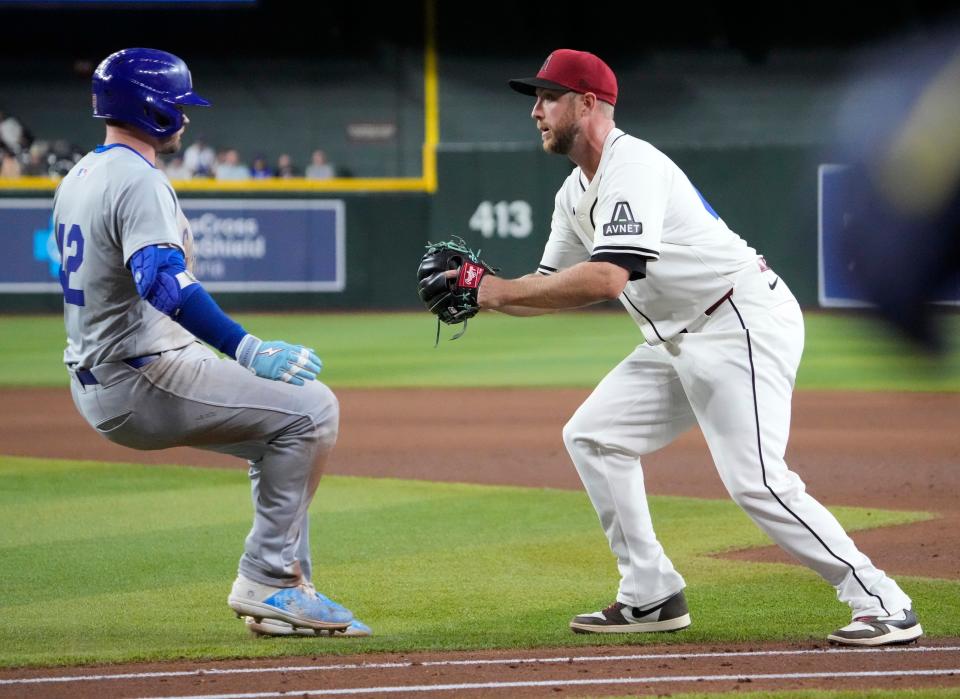What is Merrill Kelly's injury? Explaining recovery timeline for Diamondbacks' pitcher
The Diamondbacks suffered perhaps their most damaging injury blow yet earlier this week, when they placed Merrill Kelly on the 15-day injured list with a teres major strain.
They are now without two members of their first-choice starting rotation, as well as Ryne Nelson, their presumptive sixth starter. Kelly’s injury, though, is particularly deflating. He was off to an excellent start and has been a reliable fixture for years, with a 3.26 ERA since the start of 2022. The issue first appeared with discomfort in a bullpen session last week before Kelly was officially placed on the injured list Tuesday.
To answer some of the key questions facing Kelly as he works his way back, The Republic spoke with Dr. Brian Schulz. Schulz is the Los Angeles Angels team physician and an orthopedic surgeon at the Cedars-Sinai Kerlan-Jobe Institute in Anaheim.

What is the teres major?
The teres major is one of two muscles in the back of the shoulder responsible for slowing the arm down at the end of a pitching motion. The other muscle is the much larger latissimus dorsi, or the lat, which Diamondbacks left-hander Eduardo Rodriguez strained in spring training. The lat is the largest muscle in the back, while the teres major connects between the shoulder blade and upper arm.
According to Schulz, the two muscles have a similar recovery process.
“These traditionally heal very well, people get back,” Schulz said. “It's just, with muscle injuries, unfortunately it is usually a decent amount of time that's lost.”
What is Kelly’s recovery timeline?
Although the Diamondbacks have not publicly put a grade on Kelly’s strain, the good news is that it will not require surgery, according to manager Torey Lovullo.
The recovery time, though, still varies widely.
“If you've got a full tear, you're looking at probably 4-6 weeks of no throwing, rehab only to let the muscle and the tendon heal,” Schulz said. “And then you're looking at, if you've had a player shut down that long, you're gonna have to build him up over the next probably 4-6 weeks. So any kind of significant injury, you're looking at close to maybe three months.”
The opposite end of the spectrum looks much different.
“On the lighter end, maybe you shut the player down for 7-10 days,” Schulz said. “… If they're a starting pitcher then you may have to build them up a little bit slower, couple weeks. And a lot of it just depends on how long they're not throwing. If a player's only not throwing for a week, it doesn't take much to ramp back up.”
Manger Torey Lovullo was somewhat cryptic in his press conferences this week in St. Louis, but it sounded as if Kelly’s return will not be on that shorter end of that range.
“We’re not looking in terms of weeks as what we had hoped for,” Lovullo said. “So I think the next step up is a month, more than that.”
That shift in the Diamondbacks’ optimism — or lack thereof — came after Kelly underwent a pair of MRIs in recent days. When asked whether Kelly will be back by the All-Star break in mid-July, Lovullo responded, “I don't know. Hard to say.” That is nearly three months away.

What comes next for Kelly?
Lovullo said Tuesday that Kelly will undergo “some re-imaging in the coming weeks to find out how he's healing.”
While players often return to throwing without additional imaging, it is not rare to get another MRI as a measure of objective feedback to reduce the risk of re-injury.
“It's a more careful approach,” Schulz said. “It's hard to extrapolate from that how severe the injury is but it must be something that's enough where they want to make sure there's some adequate healing before they start letting the player throw again.”
What is unclear is when the Diamondbacks will have Kelly undergo re-imaging. As Schulz explained, every player responds differently in the recovery process, even with similar strains.
Last season, Max Scherzer returned in the ALCS after missing just over a month with a "low-grade" teres major strain. The injury had initially been expected to keep him out through the postseason — although he was clearly not at full strength and was limited in his effectiveness when he returned.
In recent years, the Diamondbacks have had two pitchers miss time with teres major strains. In 2021, reliever Taylor Clarke missed seven weeks. In 2022, reliever J.B. Bukauskas missed just over three months with a grade 2 strain.
The Diamondbacks have already been bit by returning a player from injury too quickly once this season. Rodriguez was initially only shut down for a week but re-injured his lat strain throwing a bullpen session. Since that re-injury, he has been shut down for 16 days and counting, and is now likely targeting a June return date.
The Diamondbacks will aim to avoid a repeat of that scenario with Kelly. But for now, he is beginning what appears to be a prolonged recovery phase before he can build towards a return.
This article originally appeared on Arizona Republic: What is Merrill Kelly's injury? Explaining a teres major strain

